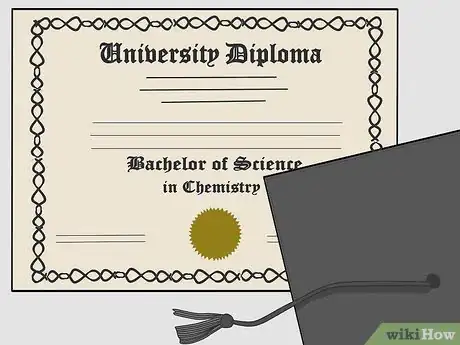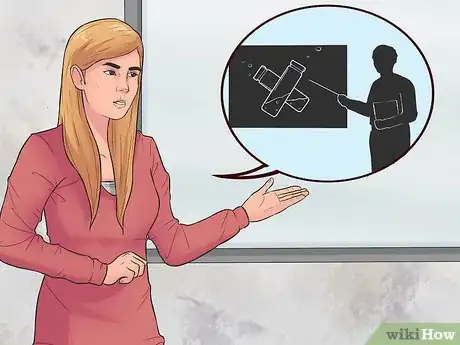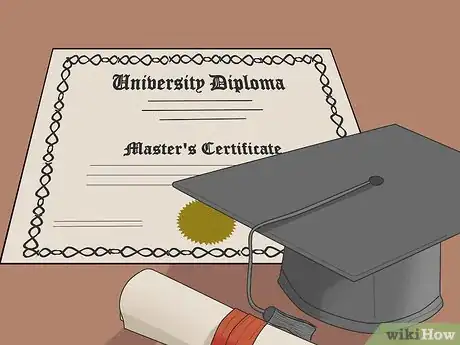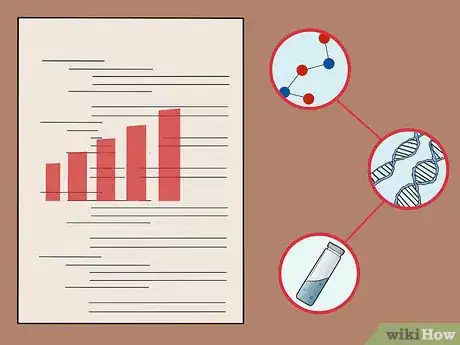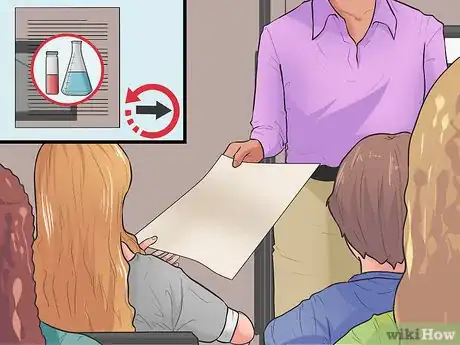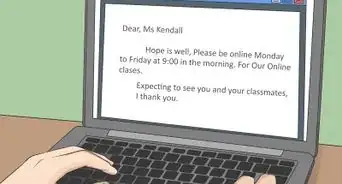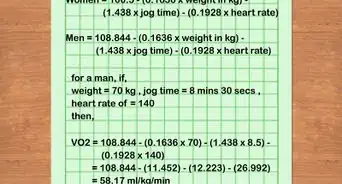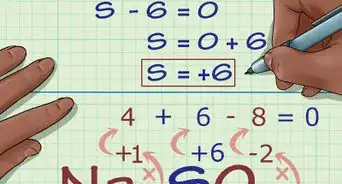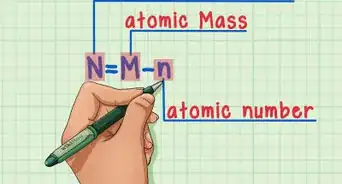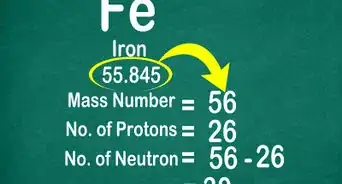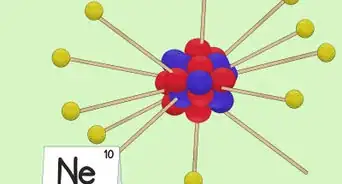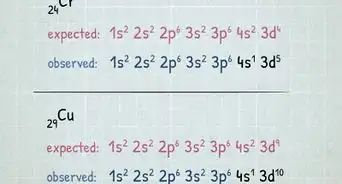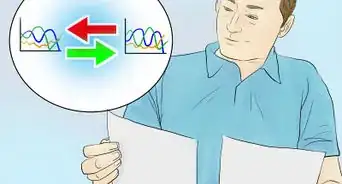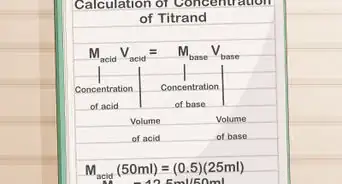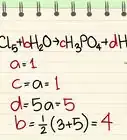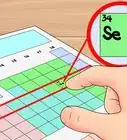This article was co-authored by Meredith Juncker, PhD. Meredith Juncker is a PhD candidate in Biochemistry and Molecular Biology at Louisiana State University Health Sciences Center. Her studies are focused on proteins and neurodegenerative diseases.
There are 10 references cited in this article, which can be found at the bottom of the page.
wikiHow marks an article as reader-approved once it receives enough positive feedback. In this case, 88% of readers who voted found the article helpful, earning it our reader-approved status.
This article has been viewed 25,986 times.
Chemistry is a complex subject and can be difficult to teach without the right resources. You must have a solid foundation in the subject before you can hope to teach it to others. With the correct knowledge of the subject, training in education, and a handful of exciting demonstrations, you can become a great chemistry teacher that your students will never forget.
Steps
Gaining the Knowledge
-
1Obtain a bachelor’s degree in chemistry. Many schools require a bachelor’s degree specific to chemistry in order to teach the subject. It’s important to have a firm understanding of chemistry in order to be able to teach it to your students.[1]
- Some schools only require a basic science certification on top of a bachelor’s in teaching, but if you are serious about teaching chemistry, you need a bachelor’s specific to the subject.
-
2Get all the necessary licenses or certifications. Public schools require a license or certification in order to be able to teach. Make sure you have all of the proper paperwork and documentation before you apply to be a teacher.[2]
- Look up the qualifications specific to the state or country where you will be teaching.
- Certifications usually require obtaining a bachelor’s degree, taking a state or PRAXIS exam, letters of recommendation, and proof of teaching experience, such as substitute teaching at a college.[3]
- Some universities offer certification as part of a chemistry bachelor’s teaching program.
- The rules for remaining licensed may vary, but it typically requires professional development courses or continuing education to stay up to date on issues and technology.
Advertisement -
3Take classes on teaching and education. Many schools require at least a basic teacher preparation program. To be a great teacher, you need to be aware of the standards you must adhere to and the latest research on teaching in the classroom.[4]
- Some universities offer teacher education programs alongside your degree program. Make sure the program is accredited by an organization like the National Council for Accreditation of Teacher Education.
- Seek out professional development opportunities that encourage new and innovative ways to teach.
- Teaching is a lot of trial and error. When you try something new, keep using the elements that work, and scrap the ones that don’t.
-
4Pursue an advanced degree in chemistry. Some schools require advanced degrees in a subject in order to teach. This path is optional, but can lead to more advanced positions in teaching chemistry. If you want to teach at the university level, you will need a doctorate.
- In most cases, teaching at the high school level does not require an advanced degree, but a master’s degree would make you more qualified. It will also likely give you a higher salary.
Teaching Basics
-
1Develop a syllabus and lesson plans. To teach any subject, you need to plan out the year and know what you are going to be teaching and when. The big ideas in chemistry are the conservation of matter and energy, the behavior and properties of matter, the particulate nature of matter, and equilibrium and driving forces.[5]
- Include all of these topics in your planning of a syllabus.
- Plan for laboratories as well. Remember, these will usually take up an entire class period. Labs help your students understand basic chemical concepts through interaction.
-
2Teach to the appropriate grade level. When writing your lesson plans, make sure you are teaching material that is appropriate to your grade level. Determine the expected outcomes for your students and look up the teaching standards relevant to your grade.[6] [7]
- Make sure any demonstrations or hands-on labs are also age-appropriate and safe.
- For elementary and middle school students, keep the concepts very generalized: talk about the basic properties of an atom, but don’t go into the details of electron shells and arrangement.
- At the high school level you can go into more depth and detail, talking about chemical reactions and balancing equations.
-
3Engage your students. You likely have a classroom of about thirty students. Not every student is going to pay attention all the time. Ask pointed questions to assess their knowledge and encourage discussion during class.
- Encourage students to participate by handing out candy or extra credit points for good questions or answers.
- Form small groups to work on chemistry problems and have the groups present to the rest of the class.
- Make a chemistry-themed quiz show and divide the class into teams.
-
4Relate the material to the real world. Students are more likely to be interested in what you are teaching if you relate the information to something they can understand. Talk about the ways chemistry has changed or effects our daily lives.[8]
- Chemical reactions allow our bodies to digest food.
- The medicine that you take when you are sick is the result of chemistry.
- Talk about food science such as making ice cream or why eggs turn white when you cook them.
- Make a battery with a lemon, copper wire, and a paper clip to show how energy changes.
-
5Be available for questions outside of class. If you are teaching chemistry at the college level, you will likely have set office hours available for students to take advantage of. If you are teaching at the high school level, you probably don’t have weekly office hours, but let your students know that you are available for extra help outside of class.
- This is particularly important around exam time. If you have time in your schedule, set aside a few hours for one or two days during the week before the test. Let your students know that this is the time for them to get extra help before test day.
- Take a whole class to review concepts and practice problems with your students before an exam.
Using Demonstrations
-
1Research and choose a demonstration. There are many different demonstrations that can safely be used in the classroom to demonstrate concepts that are part of chemistry.[9] Make sure the demonstration that you choose integrates well with the material you are trying to teach.
- When choosing a demonstration, know what the demonstration is about and why it will be helpful to your students.[10]
- If the demonstration doesn’t have a logical point to explain a concept, it is not useful in the classroom.
- Some examples of good demonstrations are freezing objects with liquid nitrogen to see how the temperature change affects the material and making ice cream out of heavy cream using ice and salt.
-
2Practice the demonstration before class. By practicing before class, you not only make sure everything works properly, but you can also figure out what you are going to say and when to say it.[11]
- Instead of announcing what will occur, ask students to observe what happens for themselves.
- It is okay to direct their observations and ask pointed questions as the demo continues.
- For example: If you’re making ice cream, ask them what role each component plays in the process. Ask them to observe the process as the liquid cream starts to turn into a more solid ice cream.
-
3Explain the demonstration to the class. Before you begin, explain what the demonstration is about and ask the students why it is relevant to what they are learning. See if they can make the correct connections. Explain just enough so they know what you are doing, but not necessarily what will happen.[12]
- Ask students to make predictions about what they think will happen. Write the predictions on the board to discuss when the demo is over.
- For example: Making ice cream is a good lesson in temperature changes and thermodynamics. When you combine the ice with the rock salt, the salt lowers the freezing point of water so the ice mixture gets colder than it would with just ice. This allows the cream to freeze into solid ice cream.[13]
-
4Perform the demonstration. Once all predictions have been made, start the demonstration. Make sure that everything is visible to all of your students and everyone is focused on the materials in front of you. Ask students to make observations during the experiment as it happens.[14]
- If the demonstration doesn’t work properly, don’t panic. Ask the students why they think it didn’t work and set it up to try again. If it works the next time, ask students what was different and why it worked.
-
5Discuss what happened and whether or not the predictions were correct. Ask the students what observations they made during the experiment. Were the predictions made before the experiment correct? Why or why not?[15]
- Use this discussion time as an introduction to the material that you are going to teach that day.
Teaching in the Laboratory
-
1Teach laboratory safety. Before beginning any lab, you must make sure your students know all about lab safety and what to do in emergency lab situations. Point out all safety showers, eye wash stations, fire extinguishers, and fire blankets at the beginning of the year. Also, hand out instructions about what to do in an emergency.[16]
- Review the pertinent lab safety procedures before every experiment to make sure students don’t forget.
-
2Assign a pre-lab report to be completed before the experiment. The pre-lab is used to test student’s comprehension and have them make predictions about what will happen in the experiment. Students will have to read through the experimental protocol and answer questions based on the material.[17]
- This assignment must be turned in before the lab begins.
-
3Discuss the protocol on the day of the experiment. Write up a detailed protocol for students and distribute it before the lab. Reading the protocol should be part of the pre-lab assignment. On the day of the lab, briefly talk through the steps of the procedure and answer any questions the students may have.
- Knowing the procedure beforehand will help things run smoothly during the actual lab.
-
4Demonstrate how to use all laboratory equipment. Before the experiment begins, make sure the students know how to use all of the necessary equipment. Demonstrate how to use everything at the beginning of the period and encourage students to ask questions if they have them.
- If the equipment is complicated and delicate make sure the students really understand how to use it to avoid damage.
-
5Supervise and be available for questions during the experiment. As students start the experiment, there will be questions about the procedure and the equipment. Encourage students to think about their questions and answer them without your help. If they are truly stumped, guide them to the correct answer.
- Answer all questions about equipment to ensure it doesn’t get damaged.
-
6Have students keep lab notebooks for observations and results. Keeping a laboratory notebook is an essential part of the scientific method and learning. Before the lab begins, students should write up the procedure in their notebook. During the lab itself they should make notes if their actual procedure deviated from the original written protocol.
- Students should write down all observations during the experiment and all of their results.
-
7Assign lab reports to assess student comprehension. The lab report is necessary for students to analyze their data and discuss their findings. In addition, they will interpret their data and come to some conclusions about the concepts being taught.[18]
- The laboratory report is used to assess your student’s understanding the lab itself and the content it is teaching.
- Watch how students respond to the lab report. If they’ve all done poorly, you may have to tweak how you present the information or change the experiment you’re running.
References
- ↑ http://www.bls.gov/ooh/education-training-and-library/high-school-teachers.htm#tab-4
- ↑ http://www.bls.gov/ooh/education-training-and-library/high-school-teachers.htm#tab-4
- ↑ http://www.teaching-certification.com/chemistry-teacher-certification.html
- ↑ http://www.bls.gov/ooh/education-training-and-library/high-school-teachers.htm#tab-4
- ↑ https://www.acs.org/content/dam/acsorg/education/policies/recommendations-for-the-teaching-of-high-school-chemistry.pdf
- ↑ https://www.acs.org/content/dam/acsorg/education/policies/recommendations-for-the-teaching-of-high-school-chemistry.pdf
- ↑ https://www.acs.org/content/acs/en/education/resources/k-8.html
- ↑ http://sciencenotes.org/what-are-some-examples-of-chemistry-in-daily-life/
- ↑ https://www.chem.wisc.edu/deptfiles/genchem/demonstrations/General_Chemistry_Demos.html
- ↑ http://ocw.mit.edu/high-school/chemistry/demonstrations/related-resources/Communicating_Sci.pdf
- ↑ http://ocw.mit.edu/high-school/chemistry/demonstrations/related-resources/Communicating_Sci.pdf
- ↑ http://ocw.mit.edu/high-school/chemistry/demonstrations/related-resources/Communicating_Sci.pdf
- ↑ http://www.scientificamerican.com/article/scrumptious-science-making-ice-cream-in-a-bag/
- ↑ http://ocw.mit.edu/high-school/chemistry/demonstrations/related-resources/Communicating_Sci.pdf
- ↑ http://bradley.bradley.edu/~campbell/elishapaper.htm
- ↑ https://www.acs.org/content/acs/en/education/policies/safety.html
- ↑ https://www.acs.org/content/dam/acsorg/education/policies/recommendations-for-the-teaching-of-high-school-chemistry.pdf
- ↑ https://www.acs.org/content/dam/acsorg/education/policies/recommendations-for-the-teaching-of-high-school-chemistry.pdf
